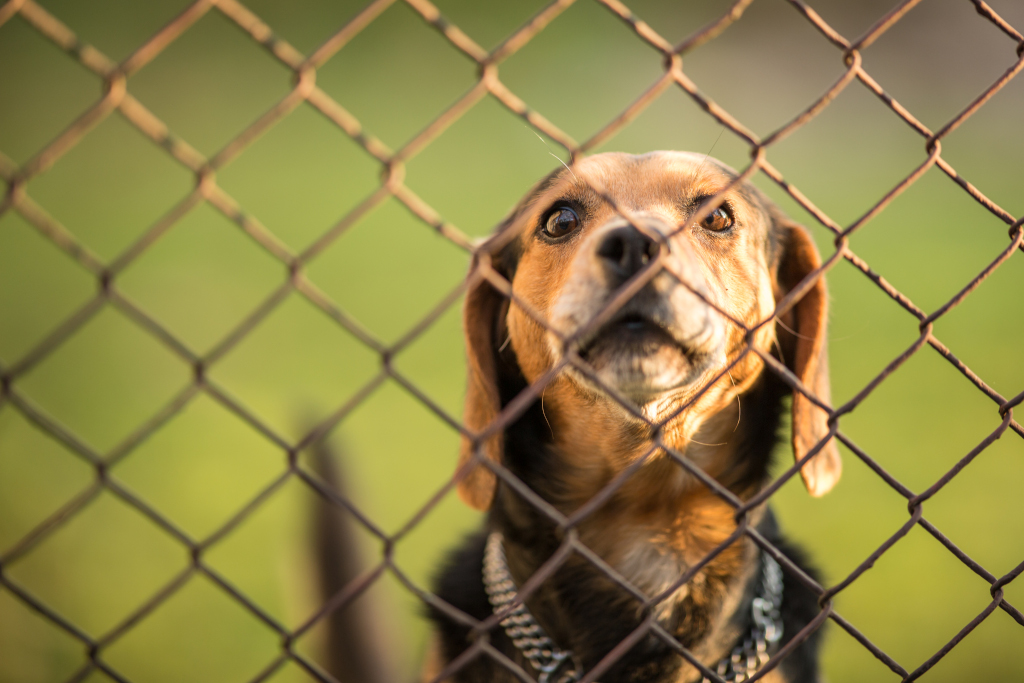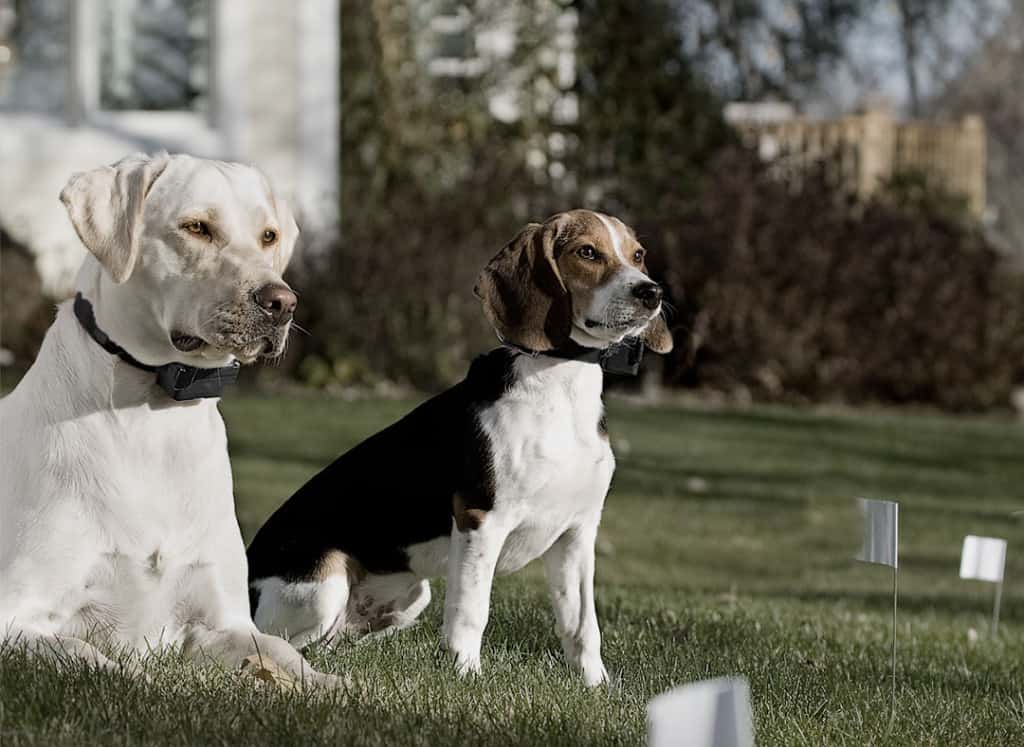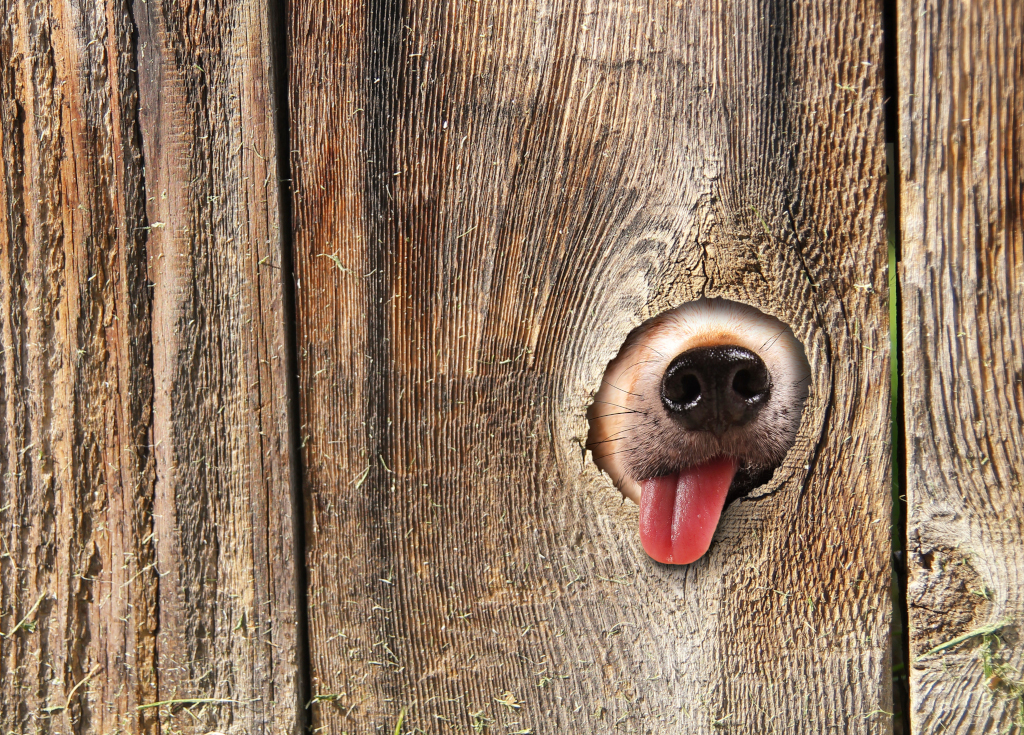You love your pup as much as your child. And as a responsible owner, you want to do what is best for your dog, take care of them, and make sure they’re safe.
You know that giving them a free run and roam of the neighborhood, even your own yard is not the safest choice. And you know exactly that you’ll need a fence to keep your canine safe. But some dogs are just too smart and determined to find a way over, through, or under the barrier. The last thing you want is for your pup to escape and stray into danger.
That’s why it is crucial to know all of your options when choosing a dog fence. There are many different types to pick from. This article will explore those differences and the pros and cons of each type, so you can make an informed decision on which one is right for your pup!
You May Also Like: How to Build a Backyard Dog Run
8 Types of Fences for Dogs
Chain-Link Fence

Chain-link fences or wire fencing are made from galvanized steel wire and attached to posts buried into the ground to keep them upright and sturdy.
They are one of the most popular fences for pets for a good reason. They are durable, easy to install, and, more importantly, affordable, making them an excellent and cost-effective option, especially for large yards. What’s more, they don’t require much maintenance whatsoever.
The downside to chain-link fences is that they can be unsightly and offer little to no privacy. And because there are spaces in between the wires, a determined escape artist can climb or chew their way through the fence.
Pros of Chain-Link Fences
- Inexpensive
- Durable
- Easy to install
- Low maintenance
Cons of Chain-Link Fences
- Unattractive
- Little to no privacy
- Determined dogs can climb or chew through
You May Also Like: How to Stop Your Dog From Chewing Things
Electric/ Invisible Fence (Underground)

An electric fence for dogs comes with a transmitter, receiver collar, wire that requires you to bury under the ground, creating an invisible barrier surrounding the area you want to enclose your dog in, and flags to mark your property boundary and for training purposes.
This type of dog fence is also known as an underground or invisible dog fence because it’s virtually undetectable, allowing you to keep your pup in without building a physical fence along the border of your property. This gives your home a cleaner look overall, and of course, more aesthetically pleasing, making it one of the most popular fences for dogs.
It will cost you significantly less than most fences and requires much less work in terms of maintenance. Let’s take chain-link type, for example. They can cost between $15 to $40 per foot for material and installation, which can easily set you back thousands of dollars. In contrast, an electric fence only costs around $200 to $400 and can cover lands up to 4 acres in size, depending on the brand. Not to mention, they are expandable (you, of course, need to pay for the additional wire and flags), plus you’ll have the flexibility to customize the shape to suit your needs.
Not only that, but they are also incredibly effective in containing your dog in your yard and preventing your pup from escaping unless you have a very stubborn dog who is very determined to get out. Why? Simple. Because your canine simply can’t chew, dig under, or jump over.
They sound like the perfect solution, right? Well, there are a few drawbacks that you should be aware of before you consider getting one. First and foremost, an electric fence can be confusing for your dog at first, especially during the training phase when you’re teaching them where their boundaries are.
Secondly, safety is always a concern. Yes, this is a valid concern because you are dealing with an electrical current, although it won’t hurt your dog if used correctly. So make sure to read the instruction carefully and start with the lowest setting possible when training your pup.
These fences are also not suitable for all dogs. You need to know your canine’s temperament. If your four-legged friend is particularly timid or fearful, an electric fence may not be the best option for them. The reason is that the shock from the collar may scare them, making them even more fearful, leading to more undesirable behavioral problems.
Lastly, an underground electric dog fence offers no protection from other animals or people since there’s no physical barrier keeping them from entering your property, which obviously can be dangerous for your pup.
Pros of Electric/ Invisible Fences (Underground)
- Very affordable
- Low maintenance
- Customizable to fit any shape and size of the property
- Your home will look more aesthetically pleasing
- Easily contain dogs in designated areas
Cons of Electric/ Invisible Fences (Underground)
- Requires training
- Not suitable for all dogs, especially those who are timid or fearful
- It won't be able to keep stray animals or strangers from entering your property
- It may hurt your dog if used incorrectly
How Do Invisible Fences Work?
Your dog wears a special collar containing a receiver tuned to the signal transmitted to the wire underground.
And as soon as your pup approaches the perimeter and gets too close to the boundary, they will hear a warning beep tone, telling them to stop. But if your fido ignores the warning and crosses the line, they’ll receive a static correction. The shock is not harmful, but it is unpleasant enough that most dogs will learn to stay within the boundaries.
Now you may think, is this humane? Are electric fences ethical? In fact, this is one of the most common questions many dog owners have. But we’ll get into that in a minute. And it’s important to note that this containment system does allow you to adjust its stimulation level. Non-shock options are also available if you aren’t comfortable with this type of training.
Electric/ Invisible Dog Fence Controversy
The debate over whether or not invisible dog fences are humane has been around for years. Some people swear by them and think they are the best way to keep their canine safe, while others believe that the shock is too severe and can harm a dog’s psychological well-being.
There is some truth to both sides of this argument. An electric fence may be cheaper and offer more convenience than a traditional fence, but it can be dangerous if misused. Shocking your pup with the highest setting is definitely unpleasant and can, in fact, affect your dog’s psyche.
Using the highest setting essentially means you rely on pain to manage your dog and teach them where the boundaries are. And that’s similar to the old-school, traditional methods of training, the ones that relied on physical punishment to teach your pup, which can often lead to more severe behavioral problems down the road.
You may have already noticed I mentioned multiple times, always starts from the lowest settings. That’s because if you start with the lowest stimulation level and gradually increase it to find at which level your dog responds best, there’s no risk of harming your pup. Similar to when you put on your headphones. You wouldn’t put them on full blast straight away, right? Instead, you would start with a low volume and slowly increase it until it’s at the optimal listening level.
And while it’s true that this fence type uses aversive-based training techniques, it’s crucial to know that the whole point of it wasn’t to punish your dog. But instead, to get their attention like someone tapping on your shoulders, serving as a reminder and reinforcing the boundary training without hurting them. If used correctly and combined with positive reinforcement like praises and treats, electric fences can be a very effective way to contain your pup.
Whichever side you’re on, it’s crucial to be aware of both sides of the argument before making a decision. And one thing, I’m not trying to convince you to use an electric fence but rather to give you my best advice so that you can make the best decision for your pup. If you’re not comfortable with the idea, there are plenty of types of dog fences to choose from.
Wireless Fence (Portable)
A wireless fence is a popular option for people who frequently move or travel with their dogs. It’s a portable system that doesn’t require installation and can be set up in minutes.
How do they operate? Well. They use the same technology and idea as the electric fences, with a transmitter that emits radio signals to create a circular boundary around your property. And it also has an adjustable correction level. So it essentially shares the same pros and cons as electric fences.
The only difference is that, unlike the underground type, which has a fixed area of coverage and needs to be installed on your property, wireless fences can be moved and relocated anywhere, meaning there’s no damage done to your yard or garden. This also makes it ideal for avid campers or RVers who frequently go camping with their pups.
However, the downside to this fence type is that it’s not as reliable, especially if your property is on a slope. Also, bad weather and obstacles, like trees or big rocks, can interfere with the signal. Plus, you won’t have the ability to customize the shape of the boundary, like you can with an electric fence.
Pros of Wireless Fences (Portable)
- No installation required
- You can set it up in minutes
- Portable and can be moved anywhere
Cons of Wireless Fences (Portable)
- Not as reliable as an electric fence
- Environment-dependent
- You can't customize the shape of the boundary
Solid Wood Fence

A solid or wooden privacy fence is another common choice and can provide a much stronger containment than other fence types, ideal for reactive dogs as they aren’t as easy to climb or jump over.
Usually made from pine, cedar, redwood, cypress, solid wood fences are some of the most durable options, although your canine can still dig under. They also provide decent privacy and security for you and your family.
And if you’re choosing wooden fences for your pup, be sure that the wood is pressure-treated because untreated wood is more susceptible to insect damage, decay, moisture, mold when exposed to the elements. A pressure-treated wooden fence can typically last for anywhere from 15 to 20 years with proper maintenance, making it a long-term investment.
However, the good look and durability of wood fences mean that they are more expensive than other options out there. Plus, it can be pretty labor-intensive, especially if you’re looking to build your own. Not only that, but they also require regular maintenance. You’ll have to stain them periodically with sealant or paint to protect them from the elements and keep them looking their best.
Pros of Wooden Dog Fences
- Provides decent privacy and security
- Very durable
- Suitable for containing reactive dogs
Cons of Wooden Dog Fences
- Expensive
- Labor-intensive
- Requires regular maintenance
Picket Fence
A picket fence is another option that you might want to consider. For the most part, it’s similar to a wooden privacy fence, but it is much shorter and has smaller slats instead of large panels.
Picket fences are made up of multiple vertical slats spaced evenly between each one. They are available in several widths at different heights and are an attractive option for adding some charm and character to your home. Nowadays, you can even get picket fences that come in different colors and styles so that you can add a unique look to your property.
Picket fences are primarily employed to enhance a property’s look, so they aren’t as strong as other fence types. They’re also not as good at containing determined medium to large dogs, as they are easy to climb or jump over. And since there are gaps between the boards, they won’t keep small animals out. Plus, toy dog breeds can easily sneak through and escape.
Pros of Picket Fences
- Inexpensive
- Aesthetic appeal
- Available in many different colors and styles
Cons of Picket Fences
- Require regular care and maintenance
- Isn't the most durable option
- Only suitable for containing laid-back dogs
- Smaller dogs can easily sneak through and escape
- Other animals can also get in
Brick Fence

Bricks are made from either concrete, sand, lime, or fly ash and are then mortared together to form a physical barrier that we call a brick fence.
They are incredibly strong and durable, making them a perfect option if you have large breeds or high-energy pups since they can neither be knocked over nor easy to climb or jump over. In addition, they’re not susceptible to weather damage and are resistant to pests.
Not only that, but they can provide absolute privacy and security, and are without a doubt, the longest-lasting fence type. Brick fences are also easy to clean and don’t require much maintenance aside from an occasional rinse with a garden hose.
One downfall to this type of fence is that the installation can be expensive and time-consuming because they require extensive foundation work. Plus, you may need to hire a professional bricklayer, which will cost even more money.
Pros of Brick Fences
- Very strong and durable
- Can deter the most determined escape artists or large, powerful dog breeds from escaping
- Offers great privacy and security
- Requires minimal maintenance
Cons of Brick Fences
- Very expensive
- Installation can be time-consuming
Modular Fence
Want a fenced-in yard but don’t want to spend a lot of money or time installing it? A modular fence could be the perfect option for you!
It is a very versatile option that is made to fit any property, containing panels, posts, rails, and all the necessary hardware to enable you to install it easily. In fact, you can do it yourself in an hour or two! You also have the flexibility to add to it or configure it to fit your specific needs.
The only downside to this fence type is that dogs can climb or jump over it if they’re determined to get out. So, it might not be the best for containing escape artists.
Pros of Modular Fences
- Very versatile
- Inexpensive
- Quick and easy to install
- It can be configured to fit any property
Cons of Modular Fences
- Escape-prone dogs can easily climb or jump over it
Metal Fence
Metal fences are made from various materials, and the most popular ones are perhaps aluminum and wrought iron. So which metal fence should you go for? Well, as with all things, there are pros and cons.
Aluminum fences are a popular choice for homeowners because they’re lightweight, rust-resistant, and are pretty much maintenance-free. And while aluminum fencing is durable, wrought iron fencing is more superior in terms of durability and security and is often used for high-security applications. However, wrought iron fences are costly, require maintenance to prevent rust, and can be pretty tricky to install.
But when it comes to keeping our furry friends contained, metal fences are definitely a strong contender. Just make sure the one you choose doesn’t have too much of a gap between the bars, or your pup can squeeze through!
Pros of Metal Fences
- Very durable and secure
- Rust-resistant (aluminum)
- Low maintenance (aluminum)
- Lightweight (aluminum)
Cons of Metal Fences
- Expensive
- Requires maintenance to prevent rusting (wrought iron)
What To Consider When Picking Your Best Dog Fences
Now that you know a little more about the different types of fencing for pets, it’s time to decide which one is best for you and your pup. Here are some things to keep in mind:
Installation and Cost
Will you be able to install the fence on your own, or will you need help? What is your budget? Are you willing to pay for a professional to do it for you? If so, what is the initial installation cost, and are there any ongoing maintenance fees?
Size and Shape of Your Yard
Do you have a small or a large yard that needs to be enclosed? Does your yard have a lot of twists and turns, or is it more open? Is your property sloped, or does it have any tight corners that would be difficult to fence in? Why is this important? Because as I mentioned earlier, some dog fencing like the wireless ones won’t work well if you have an irregularly shaped yard.
Aesthetics
Do you care how your yard looks? What material do you want your fence to be made out of? Do you like the look of wood or vinyl? Is aluminum more of your style? Maybe you’re thinking about going with wrought iron. Or you might not care whether if the fence matches your home’s exterior and only want something that offers more privacy and security. Obviously, there’s no right or wrong here. It all depends on your preference.
Durability
You’ll, of course, want to consider how durable the fence is. Is it going to be able to withstand a determined dog who likes to chew or dig? Is it weather-resistant? Will the paint flake or fade over time? You don’t want to spend good money on a dog fence that will only last you for a short period, right?
Ease of Maintenance
Some fences require more upkeep than others. So you’ll have to see what the fence is made of? Is it a material that will require regular maintenance like painting or staining? Or will it stay looking good with just a little bit of cleaning here and there? If you’re busy with work all week, it may be a good idea to go for a fence that only needs minimal maintenance, like bricks or an underground dog fence.
Your Dog's Personality Traits
Last but not least, you’ll need to consider your dog’s personality traits. How active are they? Do you have a determined escape artist?
Is your dog a jumper? How high can they jump? If they’re a super-duper Houdini pup, then you may need a 6- or 8-foot-tall fence. Otherwise, a shorter one may suffice. Or is your canine a digger, chewer, or are they the type of dog that’s smart enough to open the gate? Or maybe yours is an expert at slipping their head and shoulders through tight spaces and squeezing their way out?
Perhaps you have a high-energy dog that will climb over anything to get out of your yard? Or is your pooch on the calmer side and just wants to hang out in the backyard while you work on your tan? You get my point. Depending on what type of personality your pup has, certain types of fences would be better suited to containing them!
Recommended Reads:

